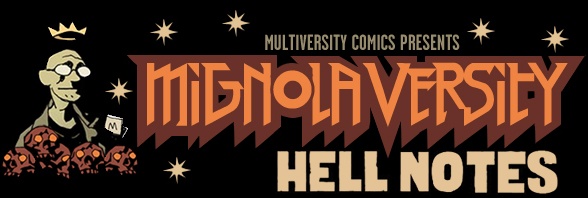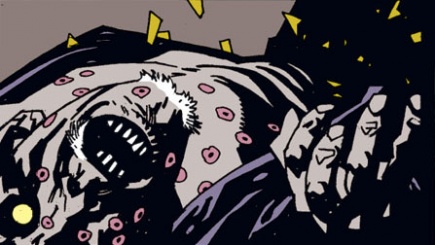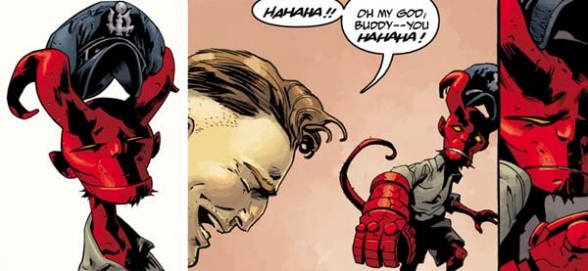
Please note, this column contains spoilers for those that have not yet read up to and including Hellboy: The Midnight Circus.
HELLBOY’S HUMAN FAMILY

Hellboy was conceived April 30, 1574 during Wulpurgis Night when Sarah Hughes, a sixteen-year-old witch, petitioned a magical power from a demon. Many years later when she was old and grey, the witch repented her former life and when she died she had her children chain her in a coffin to keep the demon from returning to claim her immortal soul.
It didn’t work, of course. On the evening of October 5, 1617, the demon came to claim his bride and dragged her down into Hell. Once there she was consumed in flame and from that flame Hellboy was born.


Hellboy wasn’t the only child of Sarah Hughes, she also had a son and daughter, who grew up to become a monk and a nun. They were the ones that chained their mother’s corpse in a coffin to keep her from being claimed by the demon that had once been her lord. Their efforts were nothing to him though, and he killed the two of them.

Though they were not able to save their mother, perhaps their sacrifice is what drew Hellboy to the East Bromwich church when he was summoned into the world instead of to Rasputin.


In Hellboy: The Wild Hunt Hellboy met Morgan le Fay, the half-sister of King Arthur and mother of his only child, Mordred. Mordred tried to steal his father’s kingdom, and the two met in the Battle of Camlan where they slew each other. But this was not the end of the Pendragon line. Mordred had three bastard sons by the witch Katheryn of Gilfach. Arthur’s surviving knights hunted down these boys and put them to death, but they never knew of a fourth child, Mordred’s daughter.
Through her, the royal bloodline continued, hidden behind other names, daughter to daughter, in an unbroken line of witches to Sarah Hughes. With her two eldest children dead, Hellboy is the Pendragon heir, the rightful King of Britain. This was later confirmed to be true when Hellboy was able to draw Excalibur from stone.

HELLBOY’S DEMONIC FAMILY

Once a god in Babylon, by the sixteenth century he was merely the Lord of the Witches of Lancashire, Abbotsbury, East Bromwich, Faversham, and Berkswell. One of his witches included the sixteen-year-old Sarah Hughes, with whom he conceived Hellboy. Many years later, he came to claim Sarah’s soul and drag her down to Hell. This event was witnessed by Hellboy four hundred years later in a vision, and yet Azzael turned to Hellboy and looked right at him, as he proclaimed the child growing inside Sarah was “his favourite son.”
But why was Hellboy his favourite son? He was the youngest of all Azzael’s children, and a half-breed with a human. It can’t be any affection for Sarah Hughes, for though he promised to make her a young girl of sixteen again, instead she was stuck on a hook and engulfed in flame as Hellboy was born. Azzael showed no remorse for what had happened.
Continued below

His sword awaits Hellboy on his seat in Pandemonium, the capital of Hell. In visions, Hellboy has seen himself wearing his fathers armour and holding his father’s sword, though he has always rejected these visions. I wonder how much Azzael really knew of Hellboy’s destiny, and if Hellboy is unknowingly walking that path…

Astaroth
Astaroth made his first appearance in a two-page comic called Pancakes. For a character that would play such an ominous role in the series, I can’t imagine a more contrary introduction.

Astaroth’s proper introduction came later in Hellboy: Box Full of Evil when he came to collect Hellboy’s cousin, Ualac, and return the Crown of the Apocalypse to Hellboy. Hellboy rejected the crown, but Astaroth told him it would wait for him in Hell, in Pandemonium, in the House of the Fly.


It was the first of many refusals. Throughout the years, Astaroth has appeared to Hellboy at times of great personal need to try to tempt him into taking the Crown of the Apocalypse, to take up his father’s sword, to command the legions of Hell and break down the barriers between Heaven, Hell, and Earth. In Hellboy: The Wild Hunt he even preyed on the Gruagach of Lough Leane, manipulating him to resurrect Nimue, the Queen of Blood.
When Hellboy was dragged into Hell by Nimue, Astaroth was waiting for him in his father’s house. He presented to Hellboy all the great sacrifices Azzael made to give Hellboy the Right Hand of Doom. Perhaps this was his final attempt to finally sway Hellboy, but it seems Astaroth’s mind was already made up that his nephew was a lost cause. He had with him Hellboy’s brothers, ready to kill Hellboy and claim his destiny as their own.

In Astaroth’s last few moments, he was utterly exposed as the manipulative creature he was, then the Leviathan showed up, killing Astaroth and Hellboy’s last living brother. At the time I thought this was a rather convenient time for the Leviathan to show up, but in retrospect, I wouldn’t be surprised at all to learn this was an event that had been orchestrated by Gamori… but I’ll talk about her further down.


There is a tale told of Saint Dunstan, who worked in a blacksmith’s shop in Mayfield, and how one day he was visited by the Devil, disguised as a woman. However, this creature was neither woman, nor the Devil, it was Hellboy’s cousin, Ualac, a minor demon of Hell. Dunstan grabbed Ualac by the nose with red-hot tongs, put the demon’s head to an anvil, and struck it with a hammer. He then sealed him in a metal box and put holy symbols on it. This was in 964.Continued below
Ualac remained sealed in that box until in 1998 he was released by Count Guarino and his wife, Bellona. Ualac possessed Bellona, regaining a body, and turned the count into a monkey. His freedom was short-lived, however, as he was immediately bound by his true name by the sorcerer, Igor Bromhead. From Ualac, Bromhead learnt of Hellboy, of the invisible crown he wore, and his secret name, “Anung Un Rama.” With this information Bromhead bound Hellboy, naming various spirits. He nearly named Astaroth as one of these, but Ualac warned him his favours come at too high a cost.

Ualac survived, but he was sealed away for another thousand years. Perhaps Hellboy shall meet him again some day in Hell.

Gamon and Lusk
Gamon and Lusk were introduced (and killed off) in Hellboy in Hell #3. I doubt Hellboy will miss his brothers though, as they spent the duration of their short meeting trying to kill him.


Both brothers are ambitious, and are easily manipulated by their uncle. He fosters animosity between them, but there is bond enough that when Astaroth strikes Gamon’s head from his shoulders, Lusk is horrified by the act. There was at least enough family feeling between them that they would not have killed each other. Before the end, Lusk at least recognised it was his uncle that was his real enemy.

Thanks to the sketchbook sections of the Library Editions, we can see that Hellboy’s sister has been kicking around in Mike Mignola’s brain since before he finished Seed of Destruction, yet he has held off even mentioning her until Hellboy in Hell #3, and even then she did not get her introduction until this month’s The Midnight Circus.

While Gamon and Lusk were Astaroth’s puppets, Gamori was closer to being Astaroth’s equal. When Hellboy first laid eyes on her, she spoke in his mind, “Do not think I’m here in answer to his call. I come and go as I choose, whatever pleases me.” She was not there at Astaroth’s bidding. Gamori has long had her own schemes, though she was unable to put them into play while Astaroth was still alive. Of course, that time has passed now…

Further insight into Gamori’s character can be gained from her name. In the Lesser Key of Solomon, a 17th century grimoire, there is a list of seventy-two spirits. The fifty-sixth on this list is Gamori (also called Gremory), “the demon of perverted love,” a duchess commanding twenty-six legions of demons. Described as a female figure with horns like a crescent moon on her head, riding atop a camel, Gamori’s office is to tell of all things past, present, and to come, and of treasures hid and what they lie in.
Continued belowSo I think it’s pretty safe to say she’s going to be trouble.

HELLBOY’S ADOPTIVE FAMILY
So that’s Hellboy’s biological family, but I would be remiss if I didn’t mention his adopted family, his real family.

Trevor Bruttenholm (pronounced “broom”) first met Hellboy in the church in East Bromwich in the late December of 1944. The young demon appeared in a burst of flame, and upon seeing him Bruttenholm uttered, “Hellboy.” The incident was referred to thereafter as “the Hellboy incident” and the child that was summoned to the church was called Hellboy even long after he had grown into a Hell-man.
At the time of their meeting, Trevor was only twenty-six, but already he had gained notoriety as a genius in the field of paranormal research. It was his passion, and had been for most of his life. The East Bromwich church had been a curiosity to since his university days, so as the most knowledgeable, it was only natural that he became the one to head the research of Hellboy, a position that would lead to creating the B.P.R.D. the following year. During his studies, he grew rather attached to Hellboy until in 1946 he adopted him as his own child.

It must have been a strange way for Hellboy to grow up. He was aware of these conversations going on, but he willingly chose to ignore them, which I suppose was all a child could really do in the face of such things. Hiding from the truth was a survival mechanism, a trait that would grow to define him, and would become one of Hellboy’s greatest character flaws.

In 1952 Bruttenholm succeeded in getting the United Nations to bestow upon Hellboy honorary human status, and a week later Hellboy joined the Bureau as an agent. In 1953 Hellboy, Bruttenholm, and Henry Middleton travelled together, investigating (among other things) the Hand of Saint Albans and the Braunton Burrows Hound. Both Hellboy and the professor would think back to these as the good old days, some of the happiest of their lives. Though the comics have often referred to Hellboy’s investigations with Professor Bruttenholm, there has not yet been a story about them. A story with the professor and Hellboy in the field is a story I’d dearly like read some day. With each new 1940s-set story that comes along, it feels like a story of that kind comes a little closer. I have my fingers tightly crossed.
The fifties were not always so idyllic. On more than one occasion Bruttenholm sent Hellboy on missions with people that ultimately were not interested in Hellboy’s well being and had their own interests at heart (like the Osiris Club in 1954 and Professor Aickman in 1956). Perhaps because of Hellboy’s surprising durability the Professor never seemed terribly concerned about the danger they put Hellboy in, rather he seemed merely disappointed in their behaviour. It’s certainly an aspect of the relationship between Hellboy and Bruttenholm that strikes me as a little distant. It can’t have been easy with Bruttenholm being both Hellboy’s father and his boss. Bruttenholm retired as director in 1958, but stayed on as a Bureau agent.
Continued below
In 1992, at the age of 74, the professor joined the Cavendish expedition expedition into the Arctic Circle. The team went missing and the professor was legally declared dead. In May 1993 he returned to his home in Brooklyn with only vague memories of his journey and no recollection at all of nearly a year of his life. He was attacked by a frog monster shortly afterwards and killed. All this happened in the very first issue of Hellboy, so in the spirit of keeping the story moving and getting into the thick of the adventure as soon as possible, Hellboy’s reactions to this event are largely unexplored. What little is known isn’t even from the comics but from Hellboy: The Companion, which described Hellboy as the sole heir in the professor’s will.

Over time, as flashback stories have explored Hellboy’s past, works like The Midnight Circus have shed more light on his relationship with the professor. As readers, we got to know him first as he died, and as we’ve learnt more, the ending of this relationship has become more of a gulf. Some day I hope a short story will be written as a kind of epilogue or memorial to him, but for now I am happy for more stories with Hellboy and Bruttenholm together rather than saying goodbye.


It can’t have been easy for the young Hellboy to grow up at the B.P.R.D. headquarters. Located at a New Mexico air force base, there were no other children around and Bruttenholm was frequently busy and travelling as part of his of duties as the Bureau director. Hellboy’s primary companions in this period were Mac, his dog, Archie (a soldier and self-proclaimed expert at making pancakes), and Margaret, the professor’s secretary and often Hellboy’s babysitter and to some extent his tutor.


In B.P.R.D.: 1948, when Archie accidentally laughed at Hellboy trying on a hat from his dress uniform, it led to Hellboy cutting off his horns for the first time. That moment drew Hellboy’s attention to the wall that stood between him and the rest of humanity, a wall that stood even between him and his closest friend. Hellboy had tried to be like Archie, and his attempt had been laughable. Given this rejection drove him to cut off his horns, I can only imagine how much it meant for him to have Bruttenholm campaign for his human status from the United Nations years later.

Archie and Hellboy share many personality traits, so it seems he left quite an impression on him, but as he’s only shown up in two stories (he was introduced in 1947, but featured more prominently in 1948), how this relationship developed and how it ended is still a mystery, and given that the character is absent from flashback stories, and that Archie never showed up when Hellboy went missing for several months in Mexico in 1956, I fear he may have died in the field. I’d like to think that he at least survived to celebrate with Hellboy on the day the United Nations granted him human status though, and was probably still alive in 1953 during the time Hellboy referred to as the good old days.
Continued below

This is the family Hellboy readers are most familiar with; Abe Sapien, Liz Sherman, Kate Corrigan, and Roger. For these guys Hellboy was their big brother at the Bureau, the one looking out for them. He was their Archie. These guys were united by their differences. They were each the reason they called the Bureau home.
Liz became a ward of the Bureau after she accidentally incinerated her family and twenty-nine neighbours and friends in 1973. Her early days at the Bureau involved being kept in isolation, observed by people that were terrified of her. Hellboy wasn’t though. He kept her company and he set down the line that the scientists were never to cross. He was the one to remind them that she was a human, not just a specimen or a monster to be feared. Liz ran away from the Bureau many times over the years, but she kept coming back because it was the closest place she had to a home.

It was always Hellboy that had to say “enough” though, and despite him saying it numerous times, the Bureau never quite figured out where that line was on their own, something they demonstrated when they put a bomb in Roger, and later when he died their immediate reaction was to dissect him rather than to treat his remains with any kind of reverence.

Roger, who had killed a Bureau agent in his waking moments, would have been hunted down and destroyed had it not been for Hellboy. It could have been very easy for him to dismiss Roger as just another monster, especially considering the agent that had died, Liz dying, and the horror that his brother had wrought. But Hellboy fought for Roger. He even named him. And he tried to make a home for him at the Bureau.

Hellboy’s absence is still felt even years later. It’s the reason why the cover for His Unmarked Grave still hit like a punch in the stomach even a decade later. Every Hellboy fan I’ve even spoken to has wanted to see this core group reunited someday, and so that really hurt.
But you know, even with Hellboy gone, the spirit of family that he fostered remains. Some comics it seems to flicker and almost go away completely, but it’s a resilient spark. As long as there is life in that spirit of family he began, there’s hope for the B.P.R.D. and the future.







